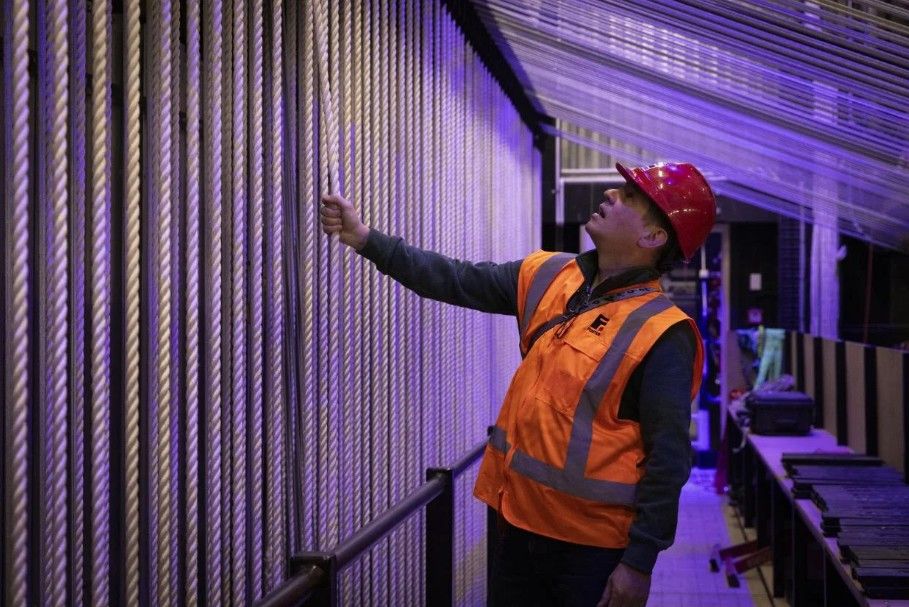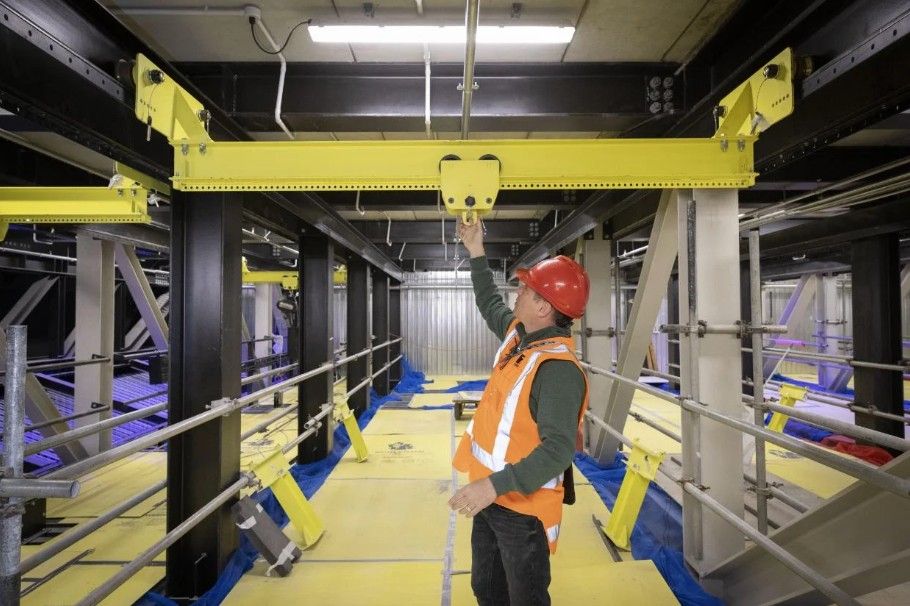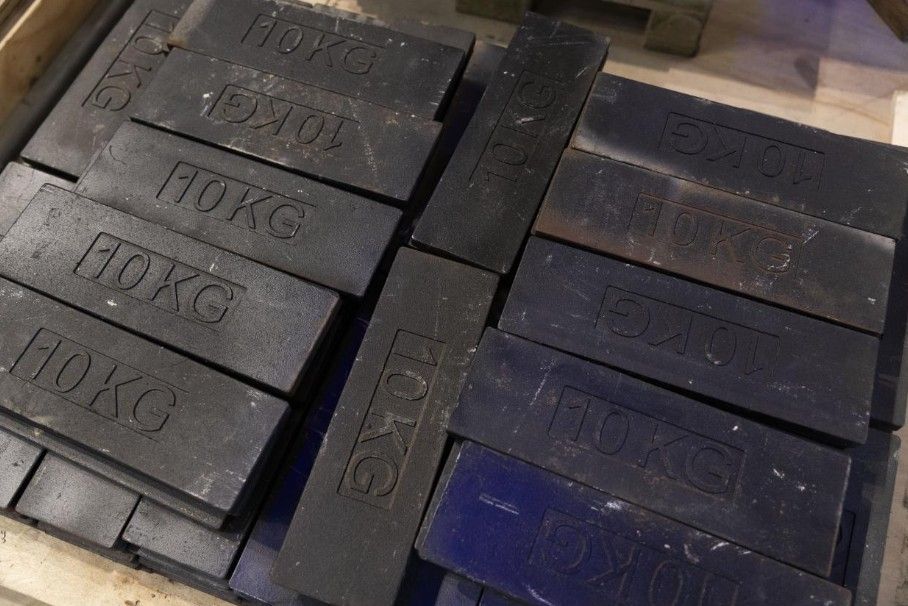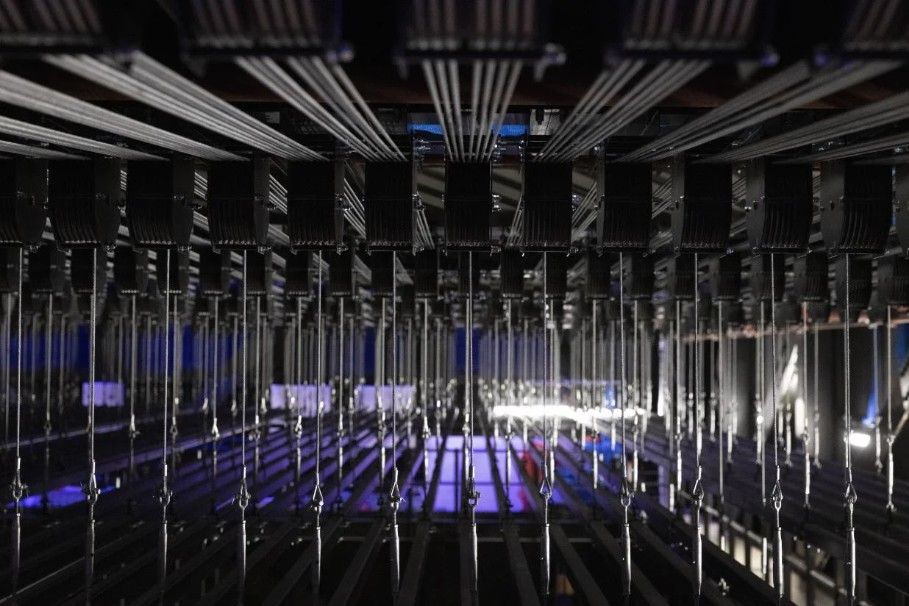Originally published in Waikato Times, Saturday 1 November 2025.
By Mike Mather.

Paul Halter tests part of the 3.5 kilometres of hauling rope that flow up to the top of the fly tower. PHOTO: Kelly Hodel / WAIKATO TIMES.
He might live on the other side of the world, but it would be an understatement to say Paul Halter is among those most eagerly wanting to see some shows at the Waikato Regional Theatre.
A senior consultant with the London-based theatre and acoustic design firm Charcoalblue, Halter has flown in from the United Kingdom to oversee the commissioning of the $80 million facility’s state-of-the-art flying system.
“The proof of the pudding will be when they do the acoustic tests ... but we are very confident that this is going to be an absolute world class concert hall,” he said during a break in the fine-tuning process.
Halter said he was impressed with the amount of room those who will be employed to run the theatre will have to move about in. Often the spaces at the back of the stage are cramped, but that is not the case here.

Paul Halter, a senior consultant at the London-based specialist theatre and acoustic design firm Charcoalblue has flown to New Zealand to oversee the commissioning of the fly system and stage engineering at the Waikato Regional Theatre. PHOTO: Kelly Hodel / WAIKATO TIMES.
“There are places and projects that we have been involved in where compromises have had to be made. This is not one of those.
“It’s going to be a venue that musicians everywhere will want to come to and perform in ... Our hope is that it will soon be right up at the top of the list, of all venues globally.”
Halter knows what he is talking about, having spent a lifetime designing, creating and renovating theatres around the world.
Involved with the Waikato Regional Theatre project since 2019, he was first inducted into the world of theatre when he was just 16 - creating scenery used as the backdrops in plays.
He has also worked for the Royal Academy of Drama and Art (RADA) and the National Theatre before joining Charcoalblue about nine years ago.

Right at the top of the fly tower is the loading gallery, where these heavy duty hoists that run along tracks fitted into steel beams are located. “This gives the theatre yet another layer of flexibility,” says Paul Halter. PHOTO: Kelly Hodel / WAIKATO TIMES.
“Working on the project from afar is one thing, but to come in here and see everything you have been doing in the physical form ... it’s quite emotional.
“It would be fair to say I’m very passionate about theatre,” he laughs. “After the wife and kids it’s the great love of my life.
“Charcoalblue are a great firm to work with and about 75% of the people employed there have a basis in theatre - they are people who know what it feels like to pull on a rope.”
Another one of those people was Byron Harrison, a Chicago-based acoustics expert who was moved to describe the experience of walking into the theatre in a post on the LinkedIn website.
“When I started doing what I do 25 years ago, working in 3D wasn’t happening on many projects,” he wrote. “I distinctly remember the emotional wallop of stepping into a room that I had built in 3D myself from the plan and section drawings done by others.
“I was caught off-guard ... by the same emotion when stepping into the Waikato Regional Theatre in Hamilton, New Zealand.

This view from near the top of the fly tower gives an indication of the sheer scale and complexity of the theatre’s flying system. PHOTO: Kelly Hodel / WAIKATO TIMES.
“This time, I’m very responsible for the form and geometry — perhaps the greatest influence I’ve personally had over any building I’ve worked on ... I look forward to sharing this building with you when it’s finished and open to enjoy, all the while wishing it weren’t just so darn far away.”
Halter is charged with the task of ensuring the mechanics behind the scenes during productions will run smoothly once the venue opens its doors in mid-January and begins hosting shows.
“This is what’s known as the tricky bit at the end of the construction job,” he grins.
We need to get the system fully commissioned, but at the same time there are a lot of other guys in the building trying to finish off floors and things like that.
“This is very much a collaborative working environment and that’s one of the things that hit me as soon as I arrived on site. There’s a feeling that everybody is on board with it. It’s fantastic.”

Stacks of counterweights are ready to be installed - There are 10 tonnes worth that will be used in the Waikato Regional Theatre’s flying system. PHOTO: Kelly Hodel / WAIKATO TIMES.
Housed in the big white box known as the fly tower that sits atop the building, directly over the stage, the system is a complex suspension system of counter-weights and pulleys, and from which pieces of scenery - backdrops and other elements that can quickly be whisked in and out during a change of scene - are hung.
Halter is adamant the Waikato Regional Theatre is one of the most flexible venues he has ever been involved with.
A big part of the reason why is the sheer number of operable elements in the fly system: There are no less than 75 “flybars” from which the scenery elements can be hung. Way up overhead are 750 pulley wheels, all connected by three and a half kilometres of hauling rope and 30 kilometres of steel wire rope, and to which 10 tonnes of counterweights can be attached.
And above all of that sits the loading gallery - where a selection of sturdy chain hoists able to pick up very heavy weights - up to 7.5 tonnes - are located.

A glimpse into the innards of the flying system gives an impression of peering into a vast musical instrument - which, in a sense, it is. PHOTO: Kelly Hodel / WAIKATO TIMES.
A lot of what Halter has been doing this week has been with safety in mind, and the flying system is being deliberately overweighted and tested to ensure its sturdiness, safety and manoeuvrability.
Panels can be attached above the stage during concerts which will literally bring the volume down and channel it out the audience, he said.
“You can reduce the aperture of the stage if it is a solo performer, and really bring the focus in on that person.
“Then, when there is a full orchestra, you can open it up, as wide as possible, so that the sound just flows out over the audience.
“It becomes a completely different venue.”
“Part of the brief from the client was to provide maximum flexibility. It’s unique in that regard... You will be able to flex from it being a drama theatre, to doing musicals, to it being a live music venue, to it being a concert hall for orchestras.
“We don’t do venues like this very often... You will be getting your money’s worth for sure.”
